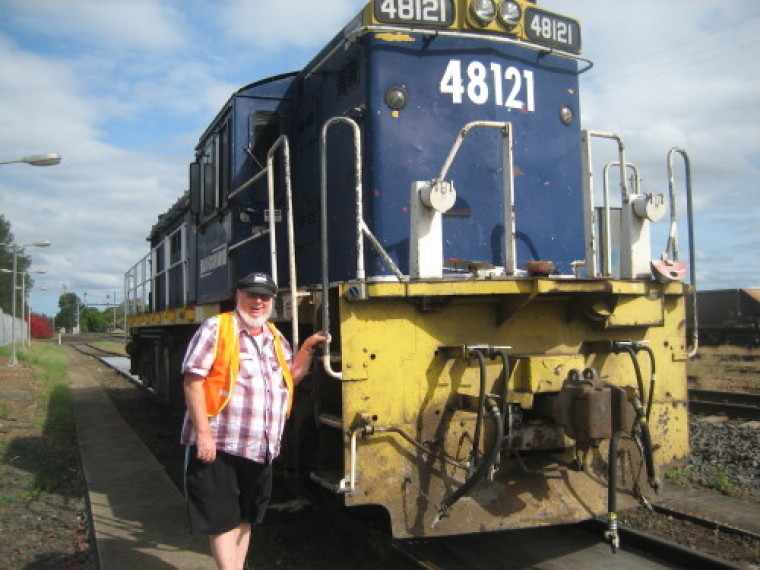
The story of Grafton Locomotive Depot is like many such country rail depots with the development of railway privatisation, depots which were always in danger of being by-passed by longer and more long distance freight trains.
There are three Driver's remaining in Grafton whose feature role are the shunting tasks around the Grafton railway yards. In the mid 80's there were 300 locomotive crews stationed in Grafton and the locomotives were housed in the old Round House situated in South Grafton.
Privatisation
With privatisation, locomotive crews from Brisbane and Taree run the 11 hour gauntlet which drive trains straight through Grafton. If all goes well, with no hold ups, no wagons breakdowns, no wagon sticking brakes (an occasional problem in my era of the 60s and 70s), these super freight trains of 400-500 metres long can do this run in 11 hours.
When unexpected delays occur, reserve locomotive crews need to relieve the south running crew at Wauchope (before Taree) and for the north running crew, somewhere outside Brisbane to Kyogle.
Once upon a tome NSWGR's Yerongapilly Depot in Brisbane in my era was the most sought after depot by locomotive crews. Now for many of the crews, it's less attractive with this long distance running. Crews sign on early evening and get into Taree early morning. They take their rest during the day in provided accommodation and do the same trip in reverse. They are away from home for two nights – they might have a day at home, and do it all over again the following night.
Moreover, it's not fast running, it's curve work most of the way, running between 60 to 80ks, slowing down for tight curves, then speeding up, which is very demanding on a train 500 metres long where you have the back section of the train doing one thing and the front doing another.
Pastoral considerations
Mark Tronson is fully aware of such running pressures on locomotive crews. As the Footplate Padre he is more so aware of such issues upon themselves and their family life.
Under privatisation, locomotive crews have a home depot but they may be sent to outlying rural depots to work trains, i.e., where the work is. Perhaps wheat trains for two-three months, then coal trains, then freighters, they may not see their home depot where their family is for long 'work' stints at a time.
It has certainly reduced the cost of locomotive crews but there are other human costs that the Footplate Padre is concerned about. Privatisation does not give railway companies a free ride as many locomotive drivers who they have trained, are choosing to go Western Australia where they are driving those huge iron ore trains and laughing all the way to the bank.
Nostalgia
Mark Tronson had come through Grafton as a teenager many times with his family. The Grafton Locomotive Depot could be seen from the South Grafton Railway Platform. Then in the late '80s the Round House which housed a hundred years of steam engines was demolished, and the depot relocated to Grafton.
The railway line runs over the Clarence River under the road bridge from South Grafton to Grafton. As most of the shunting was being done in Grafton (over the bridge), the new depot was obviously housed there, which consists of two lines. On the day that Mark Tronson visited, one 48 Class diesel was stowed. There was an oil proof cloth matting material the entire length of the track which catches any oil drips that might be lost any stowed diesel locomotive.
The Footplate Padre Mark Tronson worked 48 Classes regularly when stationed at both Port Kembla and Wollongong Depots in the early 1970's. The double 48 Class Units hauled steel laden freight trains from Port Kembla to Enfield Shunting yard in Sydney. When stationed at Wollongong Depot the 48 Class hauled passenger trains to Central Station in Sydney.
Always some history
One of the interesting social issues that has retained resonance with locomotive crews was the separation of those who decided to become employees of railway companies and those who stayed with State Rail. There was a choice and there is a sentiment abroad that those who stayed with the State system, now after almost 25 years since privatisation was initiated, have seemingly come out financially better off, especially in terms of superannuation.
When privatisation was initiated all those years ago Mark Tronson was writing his railway books (16 in total) and many locomotive crews spoke about these options to him. It was a toss-up at the time as to which might have the better long term prospects. Privatisation was very attractive initially, but to be engaged in it, a locomotive driver was required to start afresh, entitlements were no carried over.
Footplate Padre Mark Tronson says that life is like this, that you come to a fork in the road (so to speak), and both options could have very good outcomes, or one might have better prospects, but at the time, which is which is unknown. Many a corporate person gets two offers and has to decide upon one. Ministers too have to seek the Lord very carefully where there are two options in Ministry on offer.
Dr Mark Tronson is a Baptist minister (retired) who served as the Australian cricket team chaplain for 17 years (2000 ret) and established Life After Cricket in 2001. He was recognised by the Olympic Ministry Medal in 2009 presented by Carl Lewis Olympian of the Century. He has written 24 books, 16 of them of train driver's anecdotes and serves as the Footplate Padre. He enjoys writing. He is married to Delma, with four adult children and grand-children.
Mark Tronson's archive of articles can be viewed at www.pressserviceinternational.org/mark-tronson.html
Well-Being Australia's archive of articles can be viewed at
www.pressserviceinternational.org/mark-tronson.html